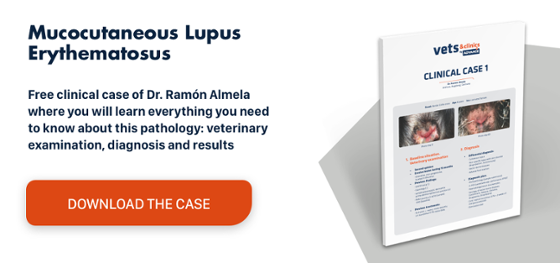Eczema in dogs: treatment. A brief review.
Diagnostic approach
Before establishing appropriate treatment for skin eczema in dogs, first the primary problem causing the visible signs must be identified and defined. Once the problem has been determined, the lesions and their location can be identified, thus obtaining a clinical method based on a more comprehensive approach to the situation.1
Knowledge of the dog’s case and medical history, coupled with physical examinations and complementary tests (cytology, skin scrapings, trichograms, biopsy, and bacterial and fungal cultures), will help establish a diagnosis and the corresponding treatment.
Clinically speaking, skin eczema in dogs causes the patient acute discomfort, which can develop into a long-term problem and tends to recur. This unpleasant sensation induces the animal scratch or bite sensitive areas, resulting in deeper and more extensive lesions all over the skin.
Before introducing an antibiotic treatment, a bacterial culture and antibiogram are necessary to establish a specific antibiotic regimen for the dog’s specific lesion. This will produce better outcomes and reduce the chances of the patient developing antibiotic resistance.
Treatment
The appearance and integrity of the skin are influenced by systemic factors, such as nutritional status, hormone levels, vascularisation and blood perfusion, so before initiating any treatment to cure eczema, we must control the primary cause (hormonal disorders, atopic or allergic dermatitis, amongst others).
Eczema can be treated either locally or systemically, depending on the extent and severity of the clinical signs.
For local treatment, the affected area must be shaved to better expose the lesion and prevent the surrounding hair from coming into contact with the eczema and delaying its healing.
Once the area in question has been shaved, the wound will be washed with physiological saline solution, removing as much dirt as possible to avoid complications, such as secondary infections. The washed area should be disinfected locally with products such as chlorhexidine or iodine solutions diluted with water.
If the wound is superficial and relatively severe but localised, ointments containing broad-spectrum topical antibiotics may be used to prevent bacterial overgrowth in the area. The first choice of active ingredients are amoxicillin/clavulanic acid, cephalexin, clindamycin or trimethoprim-potentiated sulfonamides, with recommendations for a minimum application of 2 weeks.
In cases where eczema is widespread or affects deep layers of the skin, broad-spectrum systemic antibiotics should be used to prevent secondary infections. An antibiogram is essential for selecting the most effective antibiotic, which should be administered for at least 6 weeks to ensure the treatment is successful. Quinolones or marbofloxacin are broad-spectrum antibiotics that can be used if empirical therapy is required due to the severity of the clinical picture.
In the case of pruritus, local (topical ointments) or systemic (oral or injected) corticosteroid therapy and baths with special shampoos may be used to reduce the patient’s discomfort. Antihistamines may help if the primary cause is an allergy.
Honey-based healing ointments represent a good option for accelerating wound healing, provided there are no secondary infections or damage in deeper layers.
Conclusions
Eczema in dogs are lesions that can develop secondary to hormonal, allergic, autoimmune or vascular diseases. As such, it is important to identify the primary cause of the lesions before starting the most suitable treatment, and then combining topical and systemic therapy depending on the severity of the disorder.


